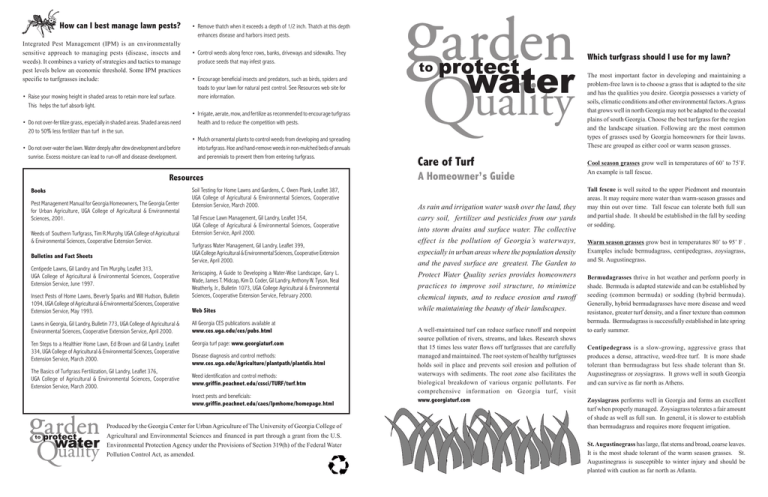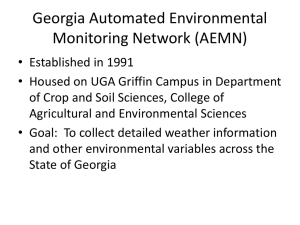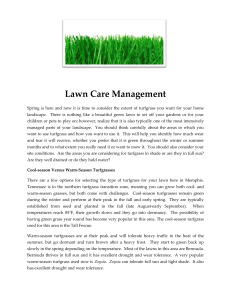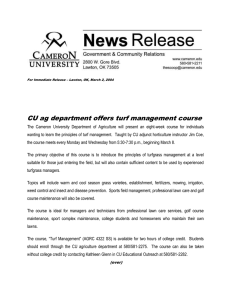How can I best manage lawn pests?
advertisement

How can I best manage lawn pests? Integrated Pest Management (IPM) is an environmentally sensitive approach to managing pests (disease, insects and weeds). It combines a variety of strategies and tactics to manage pest levels below an economic threshold. Some IPM practices specific to turfgrasses include: • Raise your mowing height in shaded areas to retain more leaf surface. This helps the turf absorb light. • Do not over-fertilize grass, especially in shaded areas. Shaded areas need 20 to 50% less fertilizer than turf in the sun. • Do not over-water the lawn. Water deeply after dew development and before sunrise. Excess moisture can lead to run-off and disease development. • Remove thatch when it exceeds a depth of 1/2 inch. Thatch at this depth enhances disease and harbors insect pests. • Control weeds along fence rows, banks, driveways and sidewalks. They produce seeds that may infest grass. Pest Management Manual for Georgia Homeowners, The Georgia Center for Urban Agriculture, UGA College of Agricultural & Environmental Sciences, 2001. Weeds of Southern Turfgrass, Tim R.Murphy, UGA College of Agricultural & Environmental Sciences, Cooperative Extension Service. Bulletins and Fact Sheets Centipede Lawns, Gil Landry and Tim Murphy, Leaflet 313, UGA College of Agricultural & Environmental Sciences, Cooperative Extension Service, June 1997. Insect Pests of Home Lawns, Beverly Sparks and Will Hudson, Bulletin 1094, UGA College of Agricultural & Environmental Sciences, Cooperative Extension Service, May 1993. • Irrigate, aerate, mow, and fertilize as recommended to encourage turfgrass health and to reduce the competition with pests. • Mulch ornamental plants to control weeds from developing and spreading into turfgrass. Hoe and hand-remove weeds in non-mulched beds of annuals and perennials to prevent them from entering turfgrass. Soil Testing for Home Lawns and Gardens, C. Owen Plank, Leaflet 387, UGA College of Agricultural & Environmental Sciences, Cooperative Extension Service, March 2000. Tall Fescue Lawn Management, Gil Landry, Leaflet 354, UGA College of Agricultural & Environmental Sciences, Cooperative Extension Service, April 2000. Turfgrass Water Management, Gil Landry, Leaflet 399, UGA College Agricultural & Environmental Sciences, Cooperative Extension Service, April 2000. Xeriscaping, A Guide to Developing a Water-Wise Landscape, Gary L. Wade, James T. Midcap, Kim D. Coder, Gil Landry, Anthony W. Tyson, Neal Weatherly, Jr., Bulletin 1073, UGA College Agricultural & Environmental Sciences, Cooperative Extension Service, February 2000. Web Sites Lawns in Georgia, Gil Landry, Bulletin 773, UGA College of Agricultural & Environmental Sciences, Cooperative Extension Service, April 2000. All Georgia CES publications available at www.ces.uga.edu/ces/pubs.html Ten Steps to a Healthier Home Lawn, Ed Brown and Gil Landry, Leaflet 334, UGA College of Agricultural & Environmental Sciences, Cooperative Extension Service, March 2000. Georgia turf page: www.georgiaturf.com The Basics of Turfgrass Fertilization, Gil Landry, Leaflet 376, UGA College of Agricultural & Environmental Sciences, Cooperative Extension Service, March 2000. The most important factor in developing and maintaining a problem-free lawn is to choose a grass that is adapted to the site and has the qualities you desire. Georgia possesses a variety of soils, climatic conditions and other environmental factors. A grass that grows well in north Georgia may not be adapted to the coastal plains of south Georgia. Choose the best turfgrass for the region and the landscape situation. Following are the most common types of grasses used by Georgia homeowners for their lawns. These are grouped as either cool or warm season grasses. • Encourage beneficial insects and predators, such as birds, spiders and toads to your lawn for natural pest control. See Resources web site for more information. Resources Books Which turfgrass should I use for my lawn? Disease diagnosis and control methods: www.ces.uga.edu/Agriculture/plantpath/plantdis.html Weed identification and control methods: www.griffin.peachnet.edu/cssci/TURF/turf.htm Insect pests and beneficials: www.griffin.peachnet.edu/caes/lpmhome/homepage.html Produced by the Georgia Center for Urban Agriculture of The University of Georgia College of Agricultural and Environmental Sciences and financed in part through a grant from the U.S. Environmental Protection Agency under the Provisions of Section 319(h) of the Federal Water Pollution Control Act, as amended. Care of Turf A Homeowner’s Guide As rain and irrigation water wash over the land, they carry soil, fertilizer and pesticides from our yards into storm drains and surface water. The collective effect is the pollution of Georgia’s waterways, especially in urban areas where the population density and the paved surface are greatest. The Garden to Protect Water Quality series provides homeowners practices to improve soil structure, to minimize chemical inputs, and to reduce erosion and runoff while maintaining the beauty of their landscapes. A well-maintained turf can reduce surface runoff and nonpoint source pollution of rivers, streams, and lakes. Research shows that 15 times less water flows off turfgrasses that are carefully managed and maintained. The root system of healthy turfgrasses holds soil in place and prevents soil erosion and pollution of waterways with sediments. The root zone also facilitates the biological breakdown of various organic pollutants. For comprehensive information on Georgia turf, visit www.georgiaturf.com Cool season grasses grow well in temperatures of 60˚ to 75˚F. An example is tall fescue. Tall fescue is well suited to the upper Piedmont and mountain areas. It may require more water than warm-season grasses and may thin out over time. Tall fescue can tolerate both full sun and partial shade. It should be established in the fall by seeding or sodding. Warm season grasses grow best in temperatures 80˚ to 95˚ F . Examples include bermudagrass, centipedegrass, zoysiagrass, and St. Augustinegrass. Bermudagrasses thrive in hot weather and perform poorly in shade. Bermuda is adapted statewide and can be established by seeding (common bermuda) or sodding (hybrid bermuda). Generally, hybrid bermudagrasses have more disease and weed resistance, greater turf density, and a finer texture than common bermuda. Bermudagrass is successfully established in late spring to early summer. Centipedegrass is a slow-growing, aggressive grass that produces a dense, attractive, weed-free turf. It is more shade tolerant than bermudagrass but less shade tolerant than St. Augustinegrass or zoysiagrass. It grows well in south Georgia and can survive as far north as Athens. Zoysiagrass performs well in Georgia and forms an excellent turf when properly managed. Zoysiagrass tolerates a fair amount of shade as well as full sun. In general, it is slower to establish than bermudagrass and requires more frequent irrigation. St. Augustinegrass has large, flat stems and broad, coarse leaves. It is the most shade tolerant of the warm season grasses. St. Augustinegrass is susceptible to winter injury and should be planted with caution as far north as Atlanta. How do I install seed, sod, and sprigs? The key to establishing of a home lawn is proper soil preparation. Without this, most lawns will eventually fail. Addition of organic matter improves water retention in a sandy soil and improves drainage and aeration in a heavier clay soil. Soil should be prepared the same whether you are planting seed, sprigs, stolons, or sod. Outlined below are steps necessary for proper soil preparation. Lawns in Georgia (listed under Resources in this pamphlet) will provide more information on soil preparation. • Obtain soil samples to determine fertilizer and lime requirements. Contact your local County Cooperative Extension Service Agent for information. • Remove all debris such as rocks, bottles, tree stumps and other wood. • Provide proper water drainage. Grade area to a 1 to 2% slope (1 to 2 foot of fall per 100 feet) away from all buildings to prevent surface water collection. • If underground drainage or irrigation systems are to be installed, do it now. Additional information is available Lawn and Garden Irrigation Design. (See Resources). • If the existing topsoil is poor, improve it with new topsoil. Spread 8 to 10 inches of topsoil over the subgrade. On steep slopes where rock outcrops exist, 12 inches of topsoil is needed for proper maintenance. • If organic matter is needed, add 1 to 3 cubic yards per 1000 square feet of lawn area. Materials, such as peat moss, shredded pine bark or leaf mold serve well. On heavy soils, add 8 to10 cubic yards of sand per 1000 square feet of lawn. Mix thoroughly with native soil to a depth of 6 to 8 inches. • Add fertilizer and lime as indicated by the soil test once the topsoil is spread and graded. Seeding - Divide the seed into two equal parts and seed in two directions at right angles to each other with a mechanical spreader. Fertilizers and pesticides should also be applied in this manner to insure a uniform distribution. Rake the seed lightly into the soil. Then roll the seedbed lightly to firm the soil. Place weed free straw over the soil to prevent erosion. Sprigging - Place grass plants, runners, rhizomes, stolons, or small sod pieces (2-4 inch plugs) in small holes on the soil surface. Place the sprigs at a 1 to 2 inch depth every 4 to 6 inches. Cover part of the sprig with soil; firm with a roller or by stepping on the soil surrounding the sprig. Sodding - Lay sod end to end as bricks are laid. Do not leave gaps which can allow weed germination. • Water fertilizer in lightly prior to planting. Whether seeding, sprigging, or sodding, be sure the source is pest free. Water immediately after installation. Many factors influence the amount and frequency of water needed for turfgrass. Soil type, type of grass, fertility level, frequency of rain, temperature, wind, and humidity affect the amount of water needed to maintain turfgrasses. Excess fertilization and hot, windy days increase demand for water, while low-level fertilization and cool, cloudy days tend to decrease demand for water. Apply water just before wilt occurs when most grasses appear dark and dull and the blades begin to fold or roll. Over-watering increases the surface runoff potential and can increase the incidence of disease. Refer to publication, Turfgrass Water Management, for more information on irrigating turfgrass. How much should I mow? Water when needed and not on a schedule. Apply only the amount of water the ground can absorb. Excess watering may lead to surface runoff. Regular mowing with a sharp blade set at the proper height is very important. Vigorous growth covers the soil surface reducing the chances of erosion. Mowing too low or scalping the turf stresses the grass plants, creating an opportunity for pest and weed invasion. Please see the below chart for mowing height for Georgia lawn grasses. Establishing turfgrasses - Water daily with up to one-fourth inch of water for the first 4 weeks. As the plants begin to take root and grow, decrease the frequency of watering and increase the amount applied each time. • Remove no more than one-third of the plant material. Grass clippings do not increase thatch build-up, if it is mowed when needed. Grass clippings should consist primarily of leaf blades which decompose quickly. • Return grass clippings to the lawn whenever possible. They provide a valuable source of nitrogen for the grass. Recycling grass clippings reduces yearly fertilizer applications by one third to one half. • During the summer, increase the mowing height by one-half inch to improve the lawn’s ability to tolerate drought and stress. • Sharpen or replace mower blades to maintain smooth cuts. Dull blades shred leaf tips causing turf to use more water and suffer undue stress. • Mix lime thoroughly with the top 3 to 5 inches of topsoil, if needed. • Mix fertilizer with the top 1 to 3 inches of soil. This places fertilizer in the root zone and prevents runoff. In the absence of a soil test, a general recommendation for a starter fertilizer is 20 to 30 pounds of a commercial grade fertilizer, such as 5-10-15, 6-12-12, 5-10-10, or 7-14-21 per 1000 square feet of lawn. How can I maintain an attractive lawn? • Do not leave clippings on the pavement where they can wash into a water source. Mowing height for lawn grasses in Georgia Grass Cutting Height (inches) Tall Fescue 2-3 Common Bermudagrass 1-2 Hybrid Bermudagrass 0.5 - 1.5 Zoysiagrass 0.5 - 1.5 Centipedegrass St. Augustinegrass 1 - 1.5 2-3 Maintaining established turfgrasses - Apply one inch of water per week during active growth. This may require two irrigation periods in one week if runoff is a problem. Fertilize cool season fescue in the fall. Fertilize warm season grasses in the spring and in the fall. Make the spring application when the turfgrass is about 50% green except for centipede which should be fertilized after it becomes green. The fall application should be made about 6 weeks before the average first frost date. See management calendar insert. • Use a mechanical spreader to distribute fertilizer. Calibrate it to make sure you are not applying a higher than necessary level of fertilizer. • Use a drop-type spreader rather than rotary-type spreader near bodies of water to minimize the possibility of fertilizer particles entering the water. • Close spreader when passing over driveways and sidewalks. Fertilizer on hard surfaces can wash off into storm water drains and surface water. • Irrigate fertilizer into the soil after application. • Fill and wash spreaders over grassy areas, not on hard surfaces. If fertilizer is deposited on such hardscapes, sweep or wash it onto the lawn. Establishing turfgrasses - Fertilize according to soil test recommendations. Maintaining established turfgrasses - Fertilize with the recommended annual rates of nitrogen as follows: • Follow directions on the fertilizer label to determine the amount needed. • Irrigate lawn after dew has fallen and before it begins to dry in the morning. This will decrease the potential for disease problems. • Apply enough water to soak the soil to a depth of 5 to 7 inches. Deep watering encourages a deep root system that can withstand drought, heat and cold. • Consider using slow-release fertilizers (e.g., UF (urea formaldehyde), SCU (sulfur-coated urea), IBDU (isobutylidene diurea), and methylene urea). Because the nutrients are released slowly, the potential for runoff and water contamination is lowered. • Thoroughly water in fertilizer with 1 inch of water. • Loosen soil by core aeration when it becomes compacted so that water can move into the soil . Fertilizer is applied to provide essential nutrients needed to maintain optimum turfgrass growth and health. For more information on turfgrass fertilization, visit the website, www.georgiaturf.com . required by the nt ou am e th in LY N Fertilize O the proper time. turfgrass. Apply it at icant pollutant of if gn si a be n ca r ze Excess fertili . urban surface water • Do not apply fertilizer on dormant lawns. • Do not fertilize your lawn before a rain storm. This can cause runoff problems. • Do not fertilize your lawn during a drought. This will increase the need for water. Lime - Lime is used to raise the soil pH. Most turfgrasses grow best at a pH level between 6.0 to 6.5. Use a dolomite source of limestone because it supplies magnesium as well as calcium. Fall is the preferred time for application because winter rainfall helps activate the lime in the soil. However, it can be applied any time. Apply lime according to soil test recommendations.




